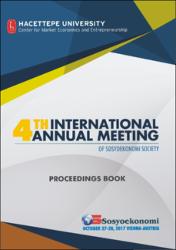| dc.description.abstract | Innovation and continuous improvement have become the most important characteristic of the era that we live in. Hence, mankind needs constant development and transformation in order to adapt and keep pace with this age. The variability of the age, adding new variables to the people’s life and compel the people for novelty and improvement who take part in a system. One of the most important factors that force human beings to change and innovate is the opportunities and threats that alteration and continuous innovation reveal. Within the context of avoiding threats and benefiting from opportunities, there is a chance that we can watch the simulations of change and transformation in the financial markets where humankind are actively involved every day. It is possible to observe at any moment the instantaneous reaction of mankind in the face of the risks and opportunities that appear in financial markets. Therefore, the field of portfolio management within the financial system can be seen as one of the most important examples of change and transformation.
The human factor that plays the most important role in portfolio management is one of the most important reasons for the fluctuation and transformation that are experienced in the stock market. Instant decisions and trading positions, due to the rapid flow of information on financial markets are constantly changing. For this reason, a system is needed to operate the decision mechanism in the most effective way to adapt to the flow of this information process. Systematization of the decision-making mechanism in portfolio management has been made with the Modern Portfolio Theory (1952) put forth by Harry Markowitz. According to the Modern Portfolio Theory, the fluctuation that each stock has experienced is called riskiness, which is calculated using the standard deviation measure. At the point of calculation of the portfolio risk, the risk of each stock together with the co-movement or inactivity (covariance and correlation coefficient) of that stock with other stocks is taken into consideration.
The concept of the market portfolio has been set forth with the help of Modern Portfolio Theory. In this theory, it has been stated that the market portfolio is the most efficient portfolio to be created by considering risk and return, and it is not possible to obtain a return on this portfolio. However, this did not prevent the search for portfolios that would provide a return on the portfolio. Efforts, to create a portfolio that provides more return than the market portfolio, have revealed the concept of an active portfolio management strategy. In 1970 and 1980, the success of the active portfolio management strategy was tried to be measured in comparison with the return of the market portfolio (Podkaminer, 2015: 9). In order to obtain a return above the market portfolio, various methods and techniques have been put forward. Having a certain cost and complexity of the methods and techniques presented, the investor has led to a preference for a simpler and cheaper market portfolio. As a result, the market portfolio has become more popular for those times. (Podkaminer, 2015: 9).
Nowadays, the volatility and risk of stock prices are increasing and the market portfolio from this change and riskiness is also significantly affected. It is noted that before today's time there are only five factors affecting stock prices, but today, more than 250 of these factors are stated (Hsu et al., 2015: 89). In addition previous statement, it is necessary to specify that the market portfolio, which most portfolio managers and investment specialists use as a benchmark for their portfolio success has a riskiness (Almahdi, 2015: 202). It is important to note that It has also led investors to consider the risk of the market portfolio, especially with the impact of the bubble in the financial markets and especially the effect of recent 2008 financial crisis. It is also worth mentioning that investors follow less risky investment strategies after the 2008 financial crisis (Denoiseux, 2014: 127). Therefore, it is possible to say that when we consider the present conditions, market portfolio takes place in Modern Portfolio Theory is still used as an important indicator, but it has lost its old popularity.
In the study, a different approach has been dealth with, in order to be an alternative to the market portfolio where risk gain importance for investors now. This strategy, generally defined as Smart beta, has different weighting techniques than the market value-weighted market portfolio. We can define the smart beta as an index creation strategy that is presented as an alternative to the market portfolio with a capitalization weighting methodology and followed by alternative indexing methods to provide a higher return than the market portfolio (Malkiel, 1999: 127, Jacobs and Levy, 2014: 1).
The aim of our work in the direction of the above mentioned is to present an alternative approach to the market portfolio that has a certain risk and to demonstrate the results of this approach. In the light of the results, besides contributing to the literature on indexing with Smart beta strategy, an alternative investment instrument has been tried to be offered to investors, mutual funds, etc. | en_US |



















